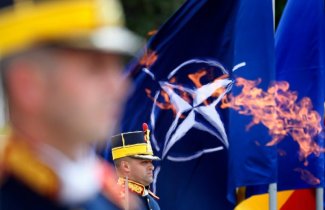Romania’s new security strategy

On 30 June, the Romanian Parliament approved the country’s new National Security Strategy for 2020-2024. 311 deputies and senators voted in favour of the document submitted by President Klaus Iohannis to both houses of parliament; only four were against it, while 38 abstained. In accordance with the new strategy’s provisions, the main objectives of Romania’s foreign and security policy remain strengthening the country’s position in the EU and NATO, as well as the further development of its strategic cooperation with the United States. In addition to maintaining defence spending at a minimum of 2% of GDP, it is also expected to include the development of NATO-EU cooperation (including between the countries on the Alliance’s eastern flank), activities aimed at increasing the presence of US troops in Romania, and promoting initiatives implemented within the EU as part of the common security and defence policy aimed at increasing security, including in the Black Sea region. In the regional context, Romania has declared that supporting the Western Balkans and the Eastern Partnership countries (especially Moldova), with the aim of definitively and irreversibly anchoring the country in European and Euro-Atlantic institutions, remains an important goal of its foreign and security policy.
The strategy names Russia’s aggressive actions in the Black Sea region and the consolidation of its military potential in Romania’s neighbourhood as potential threats to national security. Russia’s activity is mentioned several times in the document, each time presented as a factor which negatively affects Romania’s security. Specifically this includes “the escalation of existing tensions in the region related to Russia’s increasingly aggressive attitude, and the improvement of its hybrid instruments in recent years”, which “motivates Romania to continue the widespread efforts begun in 2015 to build extensive defence and deterrence capabilities”. Among other threats, the document also mentions the economic crisis caused by the COVID-19 pandemic, hybrid-war and cybernetic activities, terrorism, and what it calls illiberal tendencies in the region.
The national security strategy of Romania is re-adopted each time after the president of the state is sworn into office. Under the constitution, he is required to submit a draft new strategy to parliament within six months of taking office. The document voted through on 30 June this year replaced the strategy adopted five years ago for the period from 2015 to 2019.
Commentary
- The National Security Strategy for 2020-2024 does not contain any statements which diverge fundamentally from Romania’s security and defence policy, but it does develop the ideas contained in the previous plan. One innovation is the emphasis on the importance of Russia as a factor destabilising the situation in the Black Sea region, forcing Bucharest to increase its defence potential and strengthen its defence cooperation both with the US and within the EU and NATO. The growing sense of threat, especially in connection with the annexation of Crimea, has prompted Romania’s political elite to signal the dangers posed by the Kremlin’s policy; this was reflected in the parliament’s cross-party, almost unanimous support of the strategy. Only a group of deputies and senators from the Union for the Salvation of Romania (USR) decided not to do so, justifying their position not by their opposition to the portrayal of the region’s security situation, but rather by the failure to include corruption as another of the key threats to the country (a point that had been included in the previous strategy).
- Even before the Romanian parliament adopted it, the strategy received a sharp reaction from Russia, where local media and politicians emphasised that Romania had deemed Russia an ‘enemy’, despite the fact that this term does not appear in the document even once in relation to this country. On 11 June, the Russian Foreign Ministry spokeswoman Maria Zakharova said that “the new Romanian strategy would form a pretext to increase the presence of US and NATO forces in the Black Sea”. In her opinion, Bucharest is contributing to a further increase in tension and distrust, instead of playing a stabilising role in the region. In response, the Romanian Foreign Ministry summoned Russia’s ambassador to Bucharest, Valeri Kuzmin, and informed him that the terms used to describe Russia in Romania’s national defence strategy should not come as a surprise, because they result from Russia’s notorious actions in the region. On 19 June the head of the Romanian foreign ministry, Bogdan Aurescu, explained that Romania does not believe that Russia is a hostile state, rather that it is simply drawing attention to the aggressive actions it has undertaken in recent years, some of which have violated international law.
- Since joining NATO, Romania has worked consistently to increase the number of US forces based on its territory. Since 2007 the key location for the rotating presence of US troops in the country has been the air force base at Mihail Kogălniceanu near Constanța; this is a multimodal transport hub for US forces, at which about 1300 soldiers are stationed. Other facilities used by American forces in Romania include the training ground in Babadag (together with its railway infrastructure), the air force base in Câmpia Turzii, and the training grounds in Cincu and Smârdan. Since 2016, three SM-3 missile batteries have been located in Devesel, which are part of NATO’s (essentially, the American) missile defence system. Several hundred American sailors and civil servants are stationed on the premises on a rotating basis. At the same time, a US armoured battalion has been stationed on a rotating basis in Romania since 2017, pursuant to bilateral agreements. Bucharest has been encouraging Washington not only to increase the size of its presence further, but also to change its format from rotational to permanent, with the idea that this will give a boost to the planned investments in Romania’s military infrastructure. Over the next 20 years, the modernisation and expansion of the Mihail Kogălniceanu base will cost the Romanian budget over €2.5 billion. An additional €200 million is to be invested over five years at the air force base at Câmpia Turzii (the development of this facility will be supported by an additional US$130 million).
- On the basis of the latest strategy, it can also be concluded that Bucharest will remain consistently on the US’s side in the rivalry between Washington and Beijing. The document emphasises that although China’s long-term policy and doctrines are aimed at weakening American hegemony, the position of the United States remains unchallenged. The shape of the international security architecture is to be influenced by the process of redefining the interests of global state actors and reconfiguring the relationships between them. According to the strategy’s authors, Europe and the Asia-Pacific region will be most exposed to the consequences of this competition. For Bucharest, the priority is to ensure the security of the 5G network which is currently being developed; this can be interpreted as an announcement that Chinese businesses will be prevented from expanding the network in Romania. For several months, the Romanian authorities have been distancing themselves from cooperation with China in the fields of telecommunications technologies and nuclear energy. During his visit to Washington in August 2019, President Iohannis signed a memorandum with Donald Trump on the transparency and security of 5G technology, and in January this year Prime Minister Ludovic Orban announced the termination of cooperation with Beijing on the expansion of the nuclear power plant in Cernavodă.



